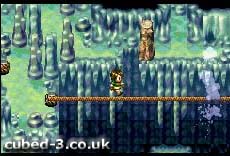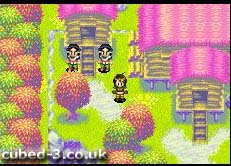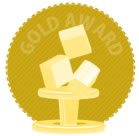Golden Sun: The Lost Age (Game Boy Advance) Review
By Adam Riley  19.09.2003
19.09.2003

After creating one of the most epic RPG titles for the SEGA Saturn in Shining Force III, it became clear that the little company of Camelot was a role-playing force to be reckoned with. Following on from this, the team produced Mario tennis and golf RPGs that are widely regarded as superlative in their respective category on the GBC, and the delectable Golden Sun for the GameBoy Advance. Now Camelot returns with the concluding chapter in the Golden Sun saga, The Lost Age. Find out just how it compares to its predecessor by reading on…
The game begins with a long-winded tale, in an attempt to help newcomers to the series understand some of the background to the forthcoming adventure. Once through with, you take over the new storyline, which continues right where Golden Sun finished off, in fact over-lapping the prequel’s ending somewhat. As opposed to Isaac in the first game, you now control an ‘Adept’ (being capable of using magical powers) by the name of Felix, who has to complete the task set during Golden Sun. Stranded on an continent that broke off in the first title, your adventure commences, and the story begins to further unfold as you progress through the quest…

The graphical splendour of the first Golden Sun was so advanced at the time of release that it still holds up as one of the most beautiful GameBoy Advance games to this very day, which is most probably what Camelot was hoping for. Why, you ask – well because nothing much has changed for this second chapter. We still have the pseudo-3D characters, the mind-blowing spell effects and the lush landscapes, with only minor tweaks present. One such addition is the fact that characters continuously move when in battle mode, rather than remaining completely static when inactive. This adds a modicum of realism, but matters are let-down by the sloppiness of a few of the enemy models, with their rough, ugly edges. It is a slight trade-off: pseudo-3D with jagged edges or smooth 2D. Honestly, being a true fan of SNES RPGs, I prefer the latter – but the effect is not too ugly on the small screen; it is when played via the GameBoy Player on the big screen that things become rather unsightly. On the whole, though, there is not much more that could be done to improve the looks of The Lost Age as it is already a pleasure to watch. It is a testament to the Camelot team that this title stands head and shoulders above all other GBA games, as well as many PSOne titles.
Fans of the original will be pleased to know that many of the old tunes make a welcome return in The Lost Age, but will also be happy in the knowledge that these classics are accompanied by some splendiferous new tracks that both fit their respective scenes perfectly and are mightily addictive to boot. Camelot has definitely crafted a powerful score, one that matches and, at times, even surpasses that of many efforts on other systems. The only irksome moments come with the battle theme music, which during many of the immensely long, later fights can easily grate on the old nerves. This is only a minor grievance, however, and possibly just a personal one. Overall the job has been carried-out to a high degree – and the music will most likely remain unrivalled until the next Nintendo game that is scored by the infamous talent that is Koji Kondo…

Since the basics of Golden Sun have been carried over into The Lost Age, players of said prequel will undoubtedly be extremely accustomed to the controls in this continuation. This is no bad thing, however, as it is a case of ‘why fix it when it is not broken?’ The menu interface is as simple to navigate as ever - with one button press you are given access to all variety of options, like your current collection of items or checking which Djinn are allotted to which character and what new Psynergy abilities they have lost or gained from this unification. Everything is nice and user-friendly, just the way it should be.
Speaking of Djinn, their presence in The Lost Age is rather more significant than before, with emphasis on collecting them all in a very Pokémon-esque fashion in order to defeat the final enemies easier, and to access a secret area contained within the game. These little elemental creatures provide different characters not only with special abilities whilst in battle scenarios, but also grant access to some devastating Summon magic that will be your saviour on many an occasion. To capture these pesky blighters you must solve puzzles to reach them – and it is not always as easy as that either, as many will now run away from you, thus leading to, sometimes awkward, chase scenes before reaching them. Once on top of one, you will occasionally obtain them without any further hassle, but more often than not you will enter into a fight to capture the Djinn. You must knock it unconscious as quickly as possibly, or else it will scarper, never to be seen again (in most cases, that is – so be sure to save every time you approach a Djinn, just in case!).

Gameplay throughout is focused solely on puzzle-based action, be it decrypting riddles to uncover a new area, or pushing blocks around to let your party pass through to the next screen. This is far more prominent than in the first game and may frustrate players after the ‘n’th sliding predicament. The other main aspect that grates after a short while is the same thing that drove people crazy in the first game – the stupid and pointless ‘Yes / No’ questions that crop up during (the many) lengthy conversations. This is Camelot’s way of trying to make the player feel like they are actually partaking in the, at times tiresome, dialogue – but it is quite surprising that it has been included once more, considering the many criticisms this feature received the first time around. The same can be said about the frequency of the random, turn-based fighting scenarios and the way that if three of your characters attack the same enemy, yet the first two kill it, rather than have the third attack move onto the next enemy, the computer instead reverts your character to a defensive position, thus wasting an oft-valuable turn. Little niggles such as these should have been rectified after much consumer complaining, and so Camelot ultimately lose marks for its either apparent laziness or completely misguided direction. But at least they did add the option of bringing over your saved data from Golden Sun if you so desire, via the means of a drawn out password, thus allowing you to control a powerful Isaac later on…
The lengthy amount of text that players will have to wade through in order to fully appreciate the intricacies of the run-of-the-mill storyline is enough to significantly push the game’s lifespan into double figures of hours, and when tied-in with the meddlesome random encounters, brain-aching puzzles and Pocket Monster-like Djinn collecting you will be looking at somewhere in the region of thirty- to forty-hours of gameplay overall. Certainly not bad for a handheld title, I’m sure many people will agree. Add to this the optional extra of two-player battling and Golden Sun: The Lost Age will be firmly locked in your GBAs, SPs or GBPs for many a month to come.

Cubed3 Rating
Exceptional - Gold Award

Golden Sun: The Lost Age may not be the pinnacle of role-playing gaming, but it certainly gives the large franchises such as Final Fantasy and Dragon Quest a good run for their money. As far as the GBA is concerned, gamers should know that the title can happily sit on the same level as the likes of the Zelda III remake and the brilliant Sword of Mana in terms of quality. Camelot deserves a round of applause, many pats on the back and probably a couple of drinks as gratitude for turning out such an exemplary piece of software.

![]() 9/10
9/10
![]() 10/10
(13 Votes)
10/10
(13 Votes)
 Out now
Out now  Out now
Out now  Out now
Out now  Out now
Out now Comments
Comments are currently disabled

 Sign In
Sign In Game Details
Game Details Subscribe to this topic
Subscribe to this topic Features
Features






 Top
Top

